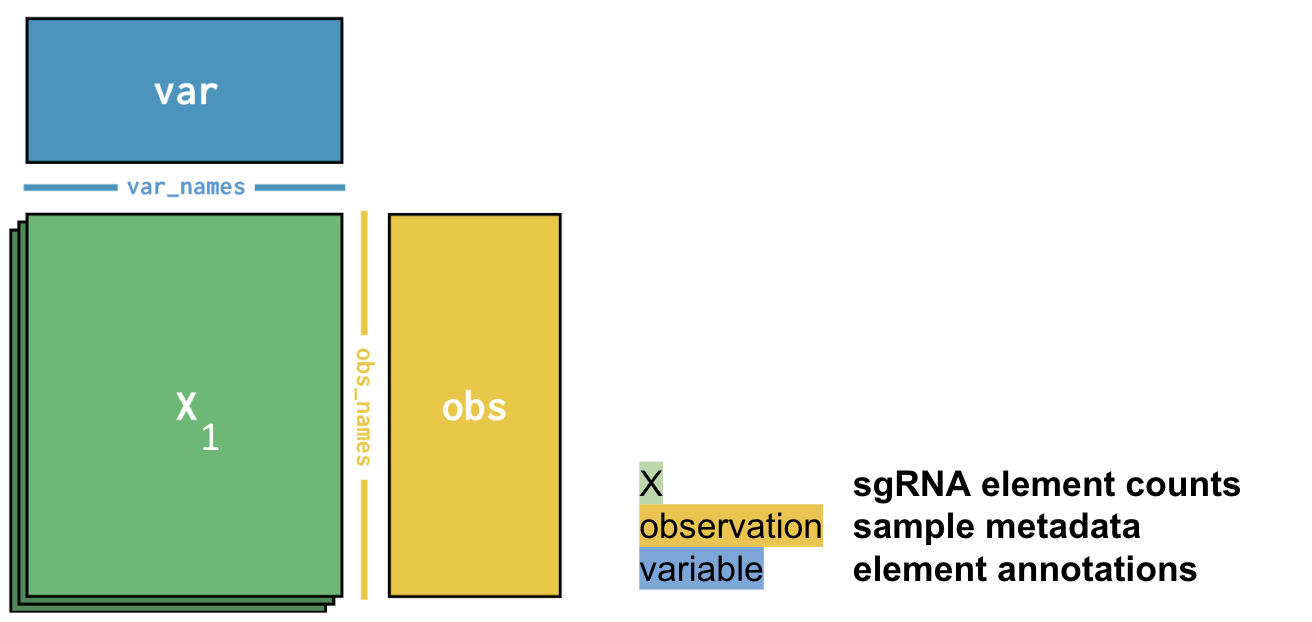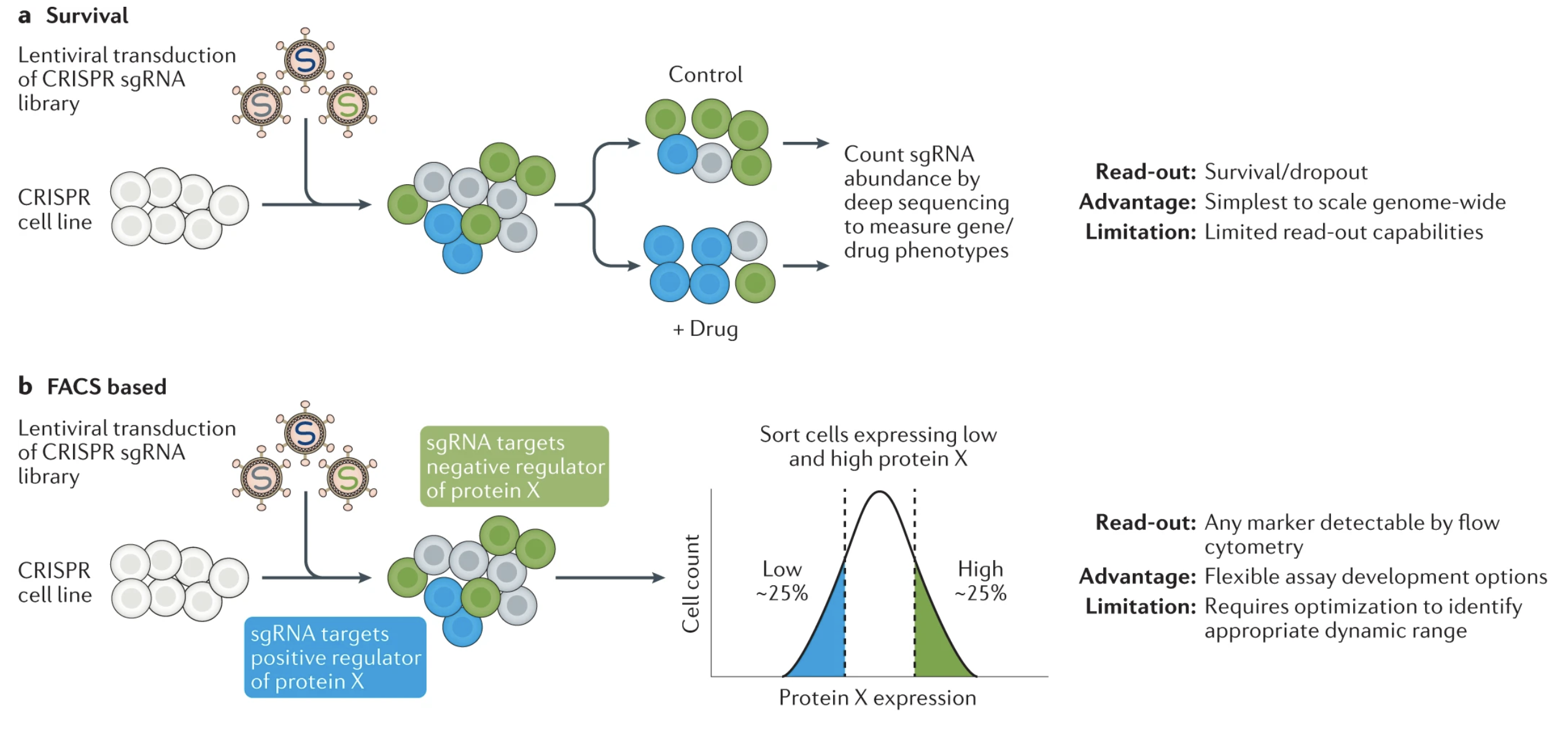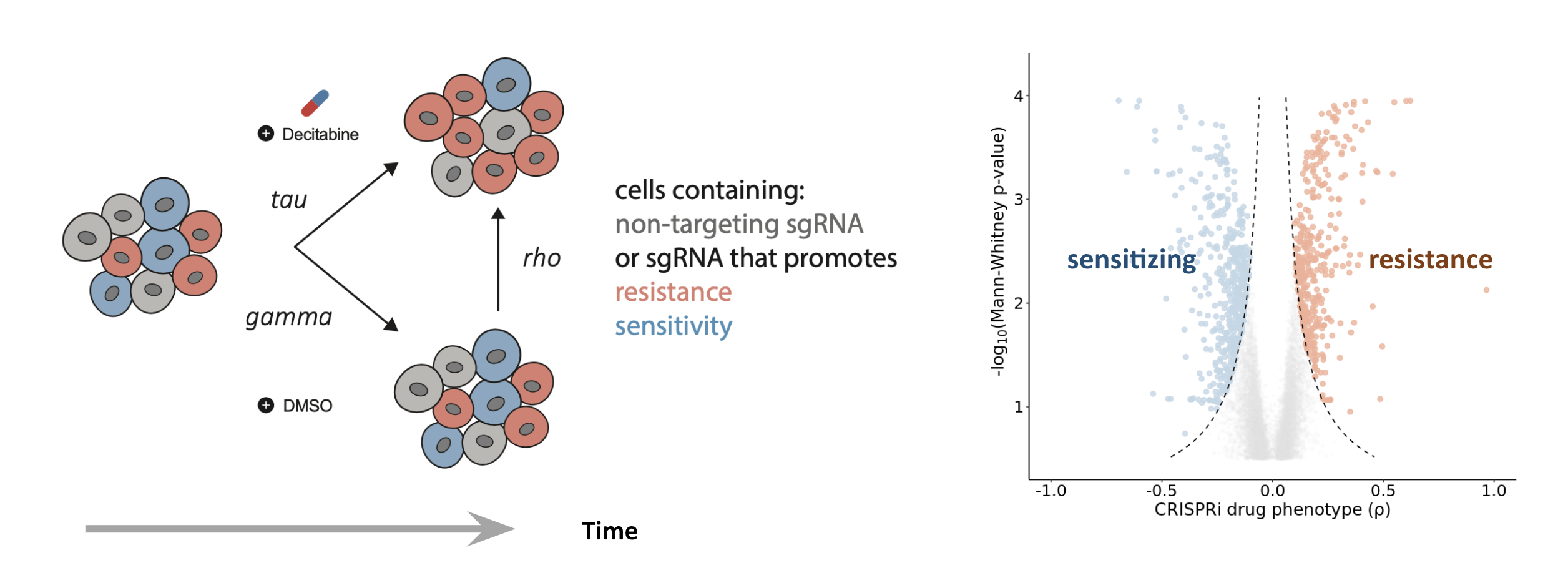Flexible analysis of high-content CRISPR screening
Project description
ScreenPro2
Introduction
TL;DR
ScreenPro2 enables perform flexible analysis on high-content CRISPR screening datasets. It has functionalities to process data from diverse CRISPR screen platforms and is designed to be modular to enable easy extension to custom CRISPR screen platforms or other commonly used platforms in addition to the ones currently implemented.
Background
Functional genomics field is evolving rapidly and many more CRISPR screen platforms are now developed. Therefore, it's important to have a standardized workflow to analyze the data from these screens. ScreenPro2 is provided to enable researchers to easily process and analyze data from CRISPR screens. Currently, you need to have a basic background in programming (especially Python) to use ScreenPro2.
ScreenPro2 is conceptually similar to the ScreenProcessing pipeline but ScreenPro2 is designed to be more modular, flexible, and extensible. Common CRISPR screen methods that we have implemented here are illustrated in a recent review paper:
Fig. 1: Common types of CRISPR screening modalities indicating advances in CRISPR methods.
Installation
ScreenPro2 is available on PyPI and can be installed with pip:
pip install ScreenPro2
For the latest version (development version) install from GitHub:
pip install git+https://github.com/ArcInstitute/ScreenPro2.git
Usage
Command Line Interface (CLI)
ScreenPro2 has a built-in command line interface (CLI). You can access the CLI by running the following command in your terminal:
screenpro --help
Python Package Usage
You can also use ScreenPro2 as a Python package. To use ScreenPro2 in your Python code, you can import it as follows:
import screenpro as scp
Analysis Workflow
Data analysis for CRISPR screens with NGS readouts can be broken down into three main steps:
Step 1: FASTQ processing
The first step in analyzing CRISPR screens with deep sequencing readouts is to process the FASTQ files and generate counts for each guide RNA element in the library. ScreenPro2 has built-in functionalities to process FASTQ files and generate counts for different types of CRISPR screens platforms (see Supported CRISPR Screen Platforms).
Command Line Interface (CLI)
ScreenPro2 has a built-in command line interface (CLI) to process FASTQ files and generate counts.
screenpro guidecounter --help
A draft code to process FASTQ files and generate counts for CRISPRa/i-single-sgRNA-screens dataset:
screenpro guidecounter
--cas-type dCas9
--single-guide-design
-l <path-to-CRISPR-library-table>
-p <path-to-fastq-directory>
-s <sample-id-1>,<sample2-id> # comma-separated list of sample ids, i.e. `<sample_id>.fastq.gz` for single sgRNA screens
-o <output-directory>
--write-count-matrix
A draft code to process FASTQ files and generate counts for CRISPRa/i-dual-sgRNA-screens dataset:
screenpro guidecounter
--cas-type dCas9
--dual-guide-design
-l <path-to-CRISPR-library-table>
-p <path-to-fastq-directory>
-s <sample-id-1>,<sample2-id> # comma-separated list of sample ids, i.e. `<sample_id>_R[1,2].fastq.gz` for dual sgRNA screens
-o <output-directory>
--write-count-matrix
Python Package Usage
In addition to the CLI, ScreenPro2 has a built-in method to process FASTQ files and generate counts in Python.
This method is implemented in the ngs module and relvent submodules.
A minor novelty here has enabled processing single, dual, or multiple sgRNA
CRISPR screens. Also, this approach can retain recombination events which can
occur in dual or higher order sgRNA CRISPR screens.
Currently, GuideCounter class from the ngs module can process FASTQ files and generate counts for standard
CRISPR screens with single or dual
guide design.
Here is a draft code to process FASTQ files and generate counts for an experiment with CRISPRa/i-dual-sgRNA-screens:
# Initialize the GuideCounter object
counter = scp.GuideCounter(cas_type = 'cas9', library_type = 'single_guide_design')
# Load the reference library
counter.load_library("<path-to-CRISPR-library-table>", sep = '\t', verbose = True, index_col=None)
# Define the samples
samples = []
## `samples` is a list of sample ids in the experiment.
## Each sample id should match the sample name in the FASTQ files, i.e. <sample_id>.fastq.gz
# Process the FASTQ files and generate counts
counter.get_counts_matrix(
fastq_dir = '<path-to-fastq-directory>',
samples = samples,
verbose = True
)
Here is a draft code to process FASTQ files and generate counts for an experiment with CRISPRa/i-dual-sgRNA-screens:
# Initialize the Counter object
counter = scp.GuideCounter(cas_type = 'dCas9', library_type = 'dual_guide_design')
# Load the reference library
counter.load_library("<path-to-CRISPR-library-table>", sep = '\t', verbose = True, index_col=None)
# Define the samples
samples = []
## `samples` is a list of sample ids in the experiment.
## Each sample id should match the sample name in the FASTQ files, i.e. <sample_id>_R[1,2].fastq.gz
# Process the FASTQ files and generate counts
counter.get_counts_matrix(
fastq_dir = '<path-to-fastq-directory>',
samples = samples,
verbose = True
)
After this, you have .counts_mat calculated in the GuideCounter object.
To proceed, you need to create an AnnData object from the counts matrix and metadata. You can use the following code to create an AnnData object:
adata = counter.build_counts_anndata()
Step 2: Phenotype calculation
Once you have the counts, you can use ScreenPro2 phenoscore and phenostats modules to calculate the phenotype scores and statistics between screen arms.
Load Data
First, load your data into an AnnData object (see anndata for more information).
The AnnData object must have the following contents:
adata.X– counts matrix (samples x targets) where each value represents the sequencing count from NGS data.adata.obs– a pandas dataframe of samples metadata including "condition" and "replicate" columns.- "condition": the condition for each sample in the experiment.
- "replicate": the replicate number for each sample in the experiment.
adata.var– a pandas dataframe of targets in sgRNA library including "target" and "targetType" columns.- "target": the target for each entry in reference sgRNA library. For single sgRNA libraries, this column can be used to store gene names. For dual or multiple targeting sgRNA libraries, this column can be used to store gene pairs or any other relevant information about the target.
- "targetType": the type of target for each entry in reference sgRNA library. Note that this column is used to
distinguish between different types of sgRNAs in the library and negative control sgRNAs can be defined as
"targetType" == "negative_control". This is important for the phenotype calculation step.
ScreenPro2 has a built-in class for different types of CRISPR screen assays. Currently, there is a class called PooledScreens
that can be used to process data from pooled CRISPR screens. To create a PooledScreens object from an AnnData object,
you can use the following example code:
import pandas as pd
import anndata as ad
from screenpro.assays import PooledScreens
adata = ad.AnnData(
X = counts_df, # pandas dataframe of counts (samples x targets)
obs = meta_df, # pandas dataframe of samples metadata including "condition" and "replicate" columns
var = target_df # pandas dataframe of targets metadata including "target" and "targetType" columns
)
screen = PooledScreens(adata)

Run workflows
Once the screen object is created, you can use several available workflows to calculate the phenotype scores and statisitics by comparing each entry in reference sgRNA library between screen arms. Then, these scores and statistics are used to nominate hits.
Drug Screen Workflow: calculate gamma, rho, and tau scores
.calculateDrugScreen method can be used to calculate the enrichment of each gene between screen arms for a drug
screen experiment. This method calculates gamma, rho, and tau scores for each gene and adds them to the
.phenotypes attribute of the PooledScreens object.
Here is an example for running the workflow on a CRISPRi-dual-sgRNA-screens dataset:
# Run the ScreenPro2 workflow for CRISPRi-dual-sgRNA-screens
screen.calculateDrugScreen(
t0='T0',
untreated='DMSO', # replace with the label for untreated condition
treated='Drug', # replace with the label for treated condition
score_level='compare_reps'
)
For example, in a Decitabine CRISPRi drug screen (see Figure 1B-C in this bioRxiv paper), each phenotype score represents a comparison between different arms of the screen and rho scores shows the main drug phenotype as illustrated here:
Flow cytometry based screen workflow: calculate phenotype score to compare high and low bins
.calculateFlowBasedScreen method can be used to calculate the enrichment of each target between high bin vs. low bin
of a flow cytometry-based screen experiment. This method calculates PhenoScore for each target and adds them to the
.phenotypes attribute of the PooledScreens object.
# Run the ScreenPro2 workflow for CRISPRi-dual-sgRNA-screens
screen.calculateFlowBasedScreen(
low_bin='low_bin', high_bin='high_bin',
score_level='compare_reps'
)
Benchmarking ScreenPro2 vs other CRISPR screen processing tools
Coming soon...
Step 3: Data visualization
Once the phenotypes are calculated, you can extract and explore the results using the .phenotypes attribute of the PooledScreens object. Currently, there are very limited functionalities built-in to visualize the results, but we are working on adding more features to make it easier for users. However, you can easily extract the results and use other libraries like seaborn and matplotlib in Python or ggplot2 in R to visualize the results.
Supported CRISPR Screen Platforms
One of the main goals of ScreenPro2 is to make it easy to process data from commonly used CRISPR screen platforms. Also, it is designed to be modular to enable easy extension to custom CRISPR screen platforms or other commonly used platforms in addition to the ones currently implemented.
Currently, ScreenPro2 has easy-to-use workflows for the following CRISPR screen platforms:
dCas9 CRISPRa/i single-sgRNA screens
Horlbeck et al. developed a CRISPR interference (CRISPRi) and CRISPR activation (CRISPRa) screening platform that uses a single sgRNA within a single plasmid and then there are up to 10 sgRNAs per gene. The multiple sgRNAs per gene can be used to perfrom statistical comparisons in guide-level or gene-level between screen arms. ScreenProcessing has been developed to process data from this type of screen. We reimplemented the same workflow in ScreenPro2 and it has all the necessary tools to process data from this type of screen.
dCas9 CRISPRa/i dual-sgRNA screens
Replogle et al. developed a CRISPR interference (CRISPRi) and CRISPR activation (CRISPRa) screening platform that uses two sgRNAs per gene within a single plasmid, and it has been used to perform genome-scale CRISPRi screens. ScreenPro2 has all the necessary tools to process data from this type of screen.
License
ScreenPro2 is licensed under the terms of the MIT license (see LICENSE for more information) and developed by Abolfazl (Abe) Arab (@abearab) as a Research Associate in the Gilbert lab at UCSF and Arc Institute.
Citation
If you use ScreenPro2 in your research, please cite the following paper.
Coming soon...
Project details
Release history Release notifications | RSS feed
Download files
Download the file for your platform. If you're not sure which to choose, learn more about installing packages.
Source Distributions
Built Distribution
File details
Details for the file ScreenPro2-0.4.13-py2.py3-none-any.whl.
File metadata
- Download URL: ScreenPro2-0.4.13-py2.py3-none-any.whl
- Upload date:
- Size: 43.4 kB
- Tags: Python 2, Python 3
- Uploaded using Trusted Publishing? No
- Uploaded via: twine/5.1.1 CPython/3.12.6
File hashes
| Algorithm | Hash digest | |
|---|---|---|
| SHA256 | a376504ef64df9895ddad80c710f255a37525daf54e1c7232eb8a91004d8f7eb |
|
| MD5 | eb04193b63ed7bbb6d712f319b385983 |
|
| BLAKE2b-256 | ab415a418c7543a82cd09fac61bf6a254906d6c38a59c2e1fa8daa263467707c |



















